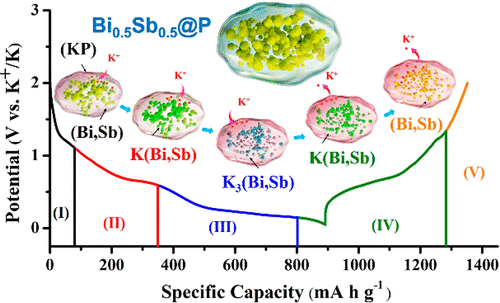Our official English website, www.x-mol.net, welcomes your feedback! (Note: you will need to create a separate account there.)
Bi-Sb Nanocrystals Embedded in Phosphorus as High-Performance Potassium Ion Battery Electrodes.
ACS Nano ( IF 17.1 ) Pub Date : 2020-09-04 , DOI: 10.1021/acsnano.0c04203 Kuan-Ting Chen,Hsing-Yu Tuan
ACS Nano ( IF 17.1 ) Pub Date : 2020-09-04 , DOI: 10.1021/acsnano.0c04203 Kuan-Ting Chen,Hsing-Yu Tuan

|
The development of high-performance potassium ion battery (KIB) electrodes requires a nanoengineering design aimed at optimizing the construction of active material/buffer material nanocomposites. These nanocomposites will alleviate the stress resulting from large volume changes induced by K+ ion insertion/extraction and enhance the electrical and ion conductivity. We report the synthesis of phosphorus-embedded ultrasmall bismuth–antimony nanocrystals (BixSb1–x@P, (0 ≤ x ≤ 1)) for KIB anodes via a facile solution precipitation at room temperature. BixSb1–x@P nanocomposites can enhance potassiation–depotassiation reactions with K+ ions, owing to several attributes. First, by adjusting the feed ratios of the Bi/Sb reactants, the composition of BixSb1–x nanocrystals can be systematically tuned for the best KIB anode performance. Second, extremely small (diameter ≈ 3 nm) BixSb1–x nanocrystals were obtained after cycling and were fixed firmly inside the P matrix. These nanocrystals were effective in buffering the large volume change and preventing the collapse of the electrode. Third, the P matrix served as a good medium for both electron and K+ ion transport to enable rapid charge and discharge processes. Fourth, thin and stable solid electrolyte interface (SEI) layers that formed on the surface of the cycled BixSb1–x@P electrodes resulted in low resistance of the overall battery electrode. Lastly, in situ X-ray diffraction analysis of K+ ion insertion/extraction into/from the BixSb1–x@P electrodes revealed that the potassium storage mechanism involves a simple, direct, and reversible reaction pathway: (Bi, Sb) ↔ K(Bi, Sb) ↔ K3(Bi, Sb). Therefore, electrodes with the optimized composition, i.e., Bi0.5Sb0.5@P, exhibited excellent electrochemical performance (in terms of specific capacity, rate capacities, and cycling stability) as KIB anodes. Bi0.5Sb0.5@P anodes retained specific capacities of 295.4 mA h g–1 at 500 mA g–1 and 339.1 mA h g–1 at 1 A g–1 after 800 and 550 cycles, respectively. Furthermore, a capacity of 258.5 mA h g–1 even at 6.5 A g–1 revealed the outstanding rate capability of the Sb-based KIB anodes. Proof-of-concept KIBs utilizing Bi0.5Sb0.5@P as an anode and PTCDA (perylenetetracarboxylic dianhydride) as a cathode were used to demonstrate the applicability of Bi0.5Sb0.5@P electrodes to full cells. This study shows that BixSb1–x@P nanocomposites are promising carbon-free anode materials for KIB anodes and are readily compatible with the commercial slurry-coating process applied in the battery manufacturing industry.
中文翻译:

Bi-Sb纳米晶体作为高性能钾离子电池电极嵌入磷中。
高性能钾离子电池(KIB)电极的开发需要进行纳米工程设计,以优化活性材料/缓冲材料纳米复合材料的结构。这些纳米复合材料将缓解由K +离子插入/引出引起的大体积变化所引起的应力,并增强电导率和离子电导率。我们报告的磷嵌入超小型铋-锑的纳米晶体合成的(Bi X Sb的1- X @P,(0≤ X ≤1)),用于KIB阳极经由一个浅显的溶液在室温下沉淀。Bi x Sb 1– x @P纳米复合材料可增强钾的钾离子-钾离子的反作用+离子,由于几个属性。首先,通过调节Bi / Sb反应物的进料比,可以系统地调节Bi x Sb 1– x纳米晶体的组成,以获得最佳的KIB阳极性能。其次,循环后获得了极小的(直径≈3 nm)Bi x Sb 1– x纳米晶体,并牢固地固定在P基质内部。这些纳米晶体可有效地缓冲大体积变化并防止电极塌陷。第三,P基质是电子和K +的良好介质离子传输以实现快速充电和放电过程。第四,在循环的Bi x Sb 1– x @P电极表面上形成的薄而稳定的固体电解质界面(SEI)层导致整个电池电极的电阻较低。最后,对K +离子从Bi x Sb 1– x @P电极中插入/抽出的原位X射线衍射分析表明,钾的存储机制涉及简单,直接和可逆的反应途径: )↔K(Bi,Sb)↔K 3(Bi,Sb)。因此,电极具有最佳的组成,即Bi 0.5 Sb 0.5P作为KIB阳极表现出出色的电化学性能(就比容量,倍率容量和循环稳定性而言)。Bi 0.5 Sb 0.5 @P阳极在800和550次循环后,在500 mA g –1时的比容量分别为295.4 mA hg –1和1 A g –1时的339.1 mA hg –1。此外,即使在6.5 A g –1时,容量仍为258.5 mA hg –1,这表明基于Sb的KIB阳极具有出色的倍率性能。以Bi 0.5 Sb 0.5 @P为阳极并以PTCDA(per四羧酸二酐)为阴极的概念验证KIB用于证明Bi的适用性0.5 Sb 0.5 @P电极至满电池。这项研究表明,Bi x Sb 1– x @P纳米复合材料是用于KIB阳极的有前途的无碳阳极材料,并且很容易与电池制造工业中应用的商业浆料涂覆工艺兼容。
更新日期:2020-09-04
中文翻译:

Bi-Sb纳米晶体作为高性能钾离子电池电极嵌入磷中。
高性能钾离子电池(KIB)电极的开发需要进行纳米工程设计,以优化活性材料/缓冲材料纳米复合材料的结构。这些纳米复合材料将缓解由K +离子插入/引出引起的大体积变化所引起的应力,并增强电导率和离子电导率。我们报告的磷嵌入超小型铋-锑的纳米晶体合成的(Bi X Sb的1- X @P,(0≤ X ≤1)),用于KIB阳极经由一个浅显的溶液在室温下沉淀。Bi x Sb 1– x @P纳米复合材料可增强钾的钾离子-钾离子的反作用+离子,由于几个属性。首先,通过调节Bi / Sb反应物的进料比,可以系统地调节Bi x Sb 1– x纳米晶体的组成,以获得最佳的KIB阳极性能。其次,循环后获得了极小的(直径≈3 nm)Bi x Sb 1– x纳米晶体,并牢固地固定在P基质内部。这些纳米晶体可有效地缓冲大体积变化并防止电极塌陷。第三,P基质是电子和K +的良好介质离子传输以实现快速充电和放电过程。第四,在循环的Bi x Sb 1– x @P电极表面上形成的薄而稳定的固体电解质界面(SEI)层导致整个电池电极的电阻较低。最后,对K +离子从Bi x Sb 1– x @P电极中插入/抽出的原位X射线衍射分析表明,钾的存储机制涉及简单,直接和可逆的反应途径: )↔K(Bi,Sb)↔K 3(Bi,Sb)。因此,电极具有最佳的组成,即Bi 0.5 Sb 0.5P作为KIB阳极表现出出色的电化学性能(就比容量,倍率容量和循环稳定性而言)。Bi 0.5 Sb 0.5 @P阳极在800和550次循环后,在500 mA g –1时的比容量分别为295.4 mA hg –1和1 A g –1时的339.1 mA hg –1。此外,即使在6.5 A g –1时,容量仍为258.5 mA hg –1,这表明基于Sb的KIB阳极具有出色的倍率性能。以Bi 0.5 Sb 0.5 @P为阳极并以PTCDA(per四羧酸二酐)为阴极的概念验证KIB用于证明Bi的适用性0.5 Sb 0.5 @P电极至满电池。这项研究表明,Bi x Sb 1– x @P纳米复合材料是用于KIB阳极的有前途的无碳阳极材料,并且很容易与电池制造工业中应用的商业浆料涂覆工艺兼容。



























 京公网安备 11010802027423号
京公网安备 11010802027423号